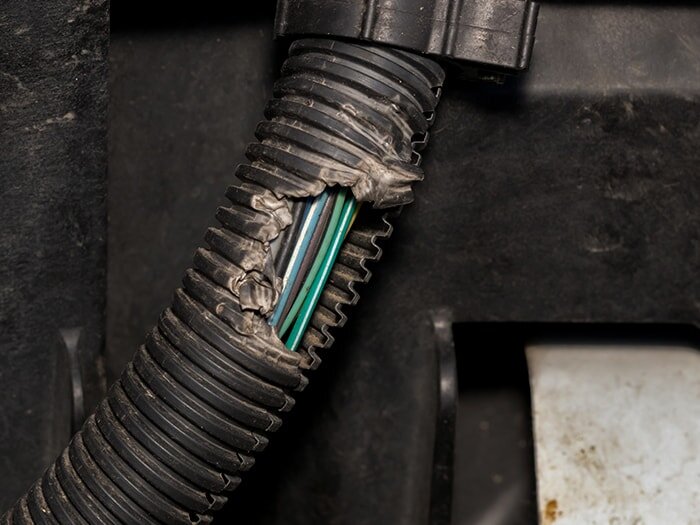Keeping Rodents out of Engine Compartments
October 1, 2021
Blog
Hardware, Paint & Home
Gardening & Plants

Are They in Your Vehicle?
If you have a vehicle that sits for extended times; a truck that you only use on weekends; a farm vehicle that is used seasonally; a recreational vehicle that is stored outside between uses; then it’s likely that rodents will try and make a comfy home inside the engine compartment. If and when they do get inside, they can do a lot of damage and cost you dollars in repairs. Rats and mice consider anything that doesn’t move and has a dry and somewhat protected space from the elements a great place to store food and make nests. There are many techniques used to prevent them from making “hay” in your engine compartment, and they work best if you combine them and don’t rely on one approach.
Steps to Take
Leave Your Hood Up At Night If you notice droppings or chew marks on wiring inside your engine compartment, the easiest and first line of defense is to take away the security the rodent feels by leaving the hood up at night. With some repetition, every night for a week or so- then reducing to every few nights, you can get them to know that under your hood isn’t as comfy as it once was. Place Rat Snap Traps on the Tread of the Front 2 Tires The front tires are the easiest place for rodents to climb and gain access to your engine compartment. Place snap traps at the front and rear of tread, plus one on the top of the tire (so you are using 3 snap-traps per tire). If the rodent uses the tire as an entry point, they need to climb past the trap. A great trap to use (for rats) is the Snap-E Rat Trap. They are easy and safe to set as well. Spray Rodent Defense into the Engine Compartment Initially, spray the engine compartment three or four times a week with rodent defense spray deterrent (available on Amazon and Walmart). Rodent Defense is an all-natural peppermint spray and can be safely sprayed on wiring and other areas you see signs of critters. Hide your dog food, cat food, and birdseed. Rats LOVE dog food (so do Opossums and Raccoons). So make sure any dog or cat food is secured in containers that they can’t open. If pet food is accessible, rodents will horde as much of it as they can, and many times this will be inside your vehicle’s air cleaner, glove compartment, or other convenient spaces inside. Use electronic deterrent devices. Rats are sensitive to sounds that humans can’t hear, so incorporating devices that emit ultrasound has been shown to annoy them. Also, if the device comes with strobe lights (Like Mouse Blocker) it’s an added benefit as it disrupts the darkness that they like. Knowing Their Habits Can Help You Beat Them- Rats Have Habits. Rodents are creatures of habit and will run the same path, eat at the same “restaurants” and the same foods. Your goal is to break the habit of using your vehicle as a safe place to hang out.
- Rats Are Cautious. They Rats won’t gorge on new food initially. They’ll eat small amounts to test it out for taste and safety. They can’t vomit, so they “test” food first and won’t go back if they get sick. Their safe paths will be marked with urine, droppings, chewed up bits of paper and other items, etc., that the rest of the rat family can detect.
- Rats Urinate on EVERYTHING. Like other animals, scent is a major indicator of territory and safety. They mark territory and safe areas by urinating in the area. They also use the scent of urine to tell who has been there and if it a known “friend”, male or female, etc.
- Rats Can’t See Well. Rats pretty much rely on their sense of smell to determine if something is safe, and their whiskers to help them navigate safely around. They can, however, see ultraviolet light, which allows them to see urine, one of their main markers.
- Rats Eat Anything. Rats are omnivores. They’ll eat plant material and meat and most food items in between.
- Rat Need to Chew. Rat teeth continue to grow, so they need to gnaw on objects, wood trim, walls, wiring, etc. to keep their teeth at manageable lengths.
- Rats Live in Colonies. A rat colony will consist of anywhere from eight to fifteen individuals that will produce up to 8 new babies every month.
Get Social! Use #mywilcolife on Facebook, Twitter, or Instagram and tag Wilco Stores.
Orders
Services
About
Your Wilco Store
Store Hours
Monday to Saturday:
8 a.m. to 8 p.m.
Sunday: 9 a.m. to 6 p.m.
Need Help?
For questions or help with online orders call: (888) 78-WILCO
Limited to stock on hand. Some items may vary from photos. Because of store size limitations or geography, some items featured may not be available in all stores but will be made available by special order during sale periods at advertised prices. All sale prices listed as “dollars off” or “% off” are discounted from our regular posted shelf price, not from discounts given with specialty, bulk or pallet pricing. Reseller and Drop-shippers must contact us for pre-approval to place orders with the intent to re-distribute.
© 2025, Wilco Farm Store